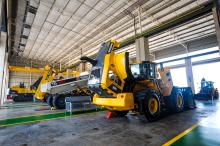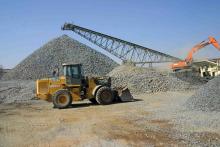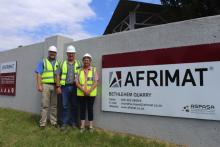
The tough economic conditions in South Africa in 2018, and the resultant lack of meaningful construction projects, resulted in a significant decline in aggregates demand in the country. The construction sector – once a key part of South Africa’s economy – has been in decline over the past 10 years. According to Stats SA, the South African construction industry lost ZAR1.7 billion (about £93.7 million) in value since the fourth quarter of 2016, falling from ZAR110 billion to ZAR108 billion in the first quarter of 2018.
A major reason for the current state of affairs in the construction industry is the lack of new infrastructure projects being rolled out by the government. Slow economic growth has had a ripple effect on the industry and the status quo will likely continue in the foreseeable future with not many big infrastructure projects in the pipeline.
In a difficult 2018, where economic growth was just over 1%, the construction sector endured yet another tough cycle. Andries van Herrden, CEO of
“The aggregates industry was directly impacted by a weaker construction sector, and as a result we saw a reduction in volumes sold. This has placed certain aggregate suppliers under immense pressure, especially those with weaker balance sheets. In 2019, volumes are expected to remain at the lower levels of 2018 and this could lead to distress of certain aggregates suppliers,” says Van Heerden.
However, it’s not all doom and gloom as the findings of the Afrimat Construction Index (ACI) for the third quarter of 2018 paint an encouraging picture. The ACI is a composite index of the level of activity within the building and construction sectors, compiled by renowned economist Dr. Roelof Botha on behalf of Afrimat.
According to Botha, the index level recorded in the third quarter of 2018 increased by almost 4% over the second quarter figure, following an impressive gain of almost 7% between April and June. The ACI was more than 9% higher in the third quarter of 2018 than the first quarter of the year.
“This reflects a welcome and broad-based recovery of the level of activity in the South African construction sector, with all of the eight constituent indicators recording gains over the second quarter. It is also encouraging that the overall result has improved by 17,6% since the first quarter of 2011, the base period, which is considerably higher than the increase in the country’s real GDP of 11,2% over this period.”
Botha indicates that the best performers during the third quarter of 2018 were the value of hardware sales, the value of buildings completed and building plans passed in the country’s larger municipalities, and the volume of building materials produced.
“Since the base period for the Index in the first quarter of 2011, all eight indicators have also recorded gains, with the most impressive ones being employment in construction, salaries and wages in construction and the value of buildings completed in the larger municipalities.” He further points out that the ACI provides a balanced and realistic view of the level of activity in the construction sector as it evens out the contradictory trends that are often portrayed by the individual components that comprise the ACI.
“Afrimat continues to find pockets of opportunity, not only in the construction and materials sector but also in the broader mining sector. The result of the third quarter ACI supports what we have been experiencing. We will always focus on our competitive advantages, which include our geographic footprint, unique metallurgy, structural cost advantage and highly entrepreneurial culture, with our iron ore operation adding support to the group overall,” says Van Heereden.










